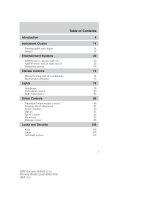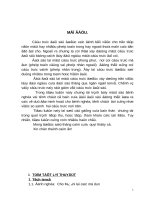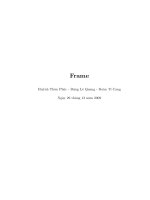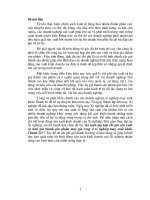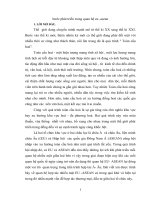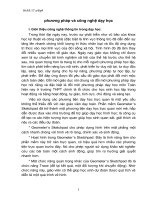OWNER 241
Bạn đang xem bản rút gọn của tài liệu. Xem và tải ngay bản đầy đủ của tài liệu tại đây (95.05 KB, 9 trang )
SƠ GD&ĐT VINH PHUC
TRƯƠNG THPT LIÊN SƠN
(Đề thi gồm: 05 trang)
ĐỀ KTCL ƠN THI THPT QUỐC GIA NĂM 20172018
Mơn: TIẾNG ANH – ĐÊ SỐ 241
Thời gian làm bài: 60 phút, không kể thời gian phát
đề
Ho va tên thi sinh:……………………………………………………………………. SBD:…………………………
Mark the letter A, B, C, or D on your answer sheet to indicate the word that differs from the
other three in the position of primary stress in each of the following questions.
Question 01: A. instructor B. influence
C. inflation
D. intelligent
Question 02: A. diagram
B. diaper
C. diamond
D. diagonal
Mark the letter A, B, C, or D on your answer sheet to indicate the word whose underlined part
differs from the other three in pronunciation in each of the following questions.
Question 03: A. national
B. suggestion
C. venture
D. fortunate
Question 04: A. decision
B. disease
C. divisible
D. design
Mark the letter A, B, C, or D on your answer sheet to indicate the correct answer to each of the
following questions.
Question 05: The audience applauded for five minutes after the________ ended.
A. performance
B. affair
C. confessio
D. treatment
Question 06: It is difficult to find a________ in the Washington area for less than $1,200 a month
A. two-bedroom apartment
B. two-bedroom apartments
C. two-bedrooms apartments
D. two-bedrooms apartment
Question 07: Dozens of cyclists are________ on the city’s roads each year.
A. damaged
B. wounded
C. crashed
D. injured
Question 08: Can you________ a pound? I need some money for the coffee machine.
A. offer
B. change
C. exchange
D. give
Question 09: Arithmetic, simple calculation with________, is one branch of mathematics.
A. figures
B. numbers
C. signs
D. digits
Question 10: Your personality is important________ the success of your work.
A. in
B. to
C. for
D. on
Question 11: Many technological innovations, such as the telephone, ________ the result of sudden
bursts of inspiration in fact were preceded by many inconclusive efforts.
A. that appear to be B. and appear to be
C. whose appearanceD. are appearing
Question 12: Put this________ in the garbage can.
A. burden
B. habit
C. rubbish
D. labor
Question 13: Except for the Sun, all stars are too far from the Earth for their distances________ in
miles or kilometers.
A. conveniently measured
B. to measure conveniently
C. to be conveniently measured
D. which conveniently measured
Question 14: The more he tried to explain________.
A. the most confused we got
B. the more confused we got
C. the many confused we got
D. the much confused we got
Question 15: The________ in my neighbourhood are well cared by the authorities.
A. inability
B. unable
C. disabled
D. disabilities
Question 16: I’ll introduce to you the m an________ support is necessary for your project.
A. whose
B. who
C. that
D. whom
Mark the letter A, B, C, or D on your answer sheet to indicate the sentence that best completes
each of the following exchanges.
Question 17: ~ Alex: “____________” ~ Bob: “Not bad, but I wish I’d had more time to finish it.”
A. Tell me about your last trip abroad.
B. How about your interview?
C. Was your paper on thermodynamics successful?
D. Was Mr. Peterson’s lecture interesting?
Question 18: ~ Ann: “Mum. May I use your red dress tonight?” ~ Buick: “____________”
A. Sorry. Tim needs it for our get-together party tonight.
B. What a pity! I haven’t collected it from the pawnshop.
C. No! Your dad has borrowed it for weeks.
D. Oh, poor me. I lost it on the way from shopping.
Mark the letter A, B, C, or D on your answer sheet to indicate the sentence that is closest in
meaning to each of the following questions.
Question 19: It's possible that the plane has been delayed because of the bad weather.
A. The obvious reason for the plane's being delayed for so long is the bad weather.
B. The weather must have been very bad, or else their plane wouldn’t have been delayed.
C. It’s certainly the bad weather which has resulted in the plane’s being late.
D. It may be the bad weather that has caused the plane to be delayed.
Question 20: The test is designed so that the questions get progressively harder.
A. The format of the exam is such that it starts with easier questions and continues by
gradually increasing in difficulty.
B. Though the exam may seem very challenging at first glance, if you’ve made progress, you
can do it well.
C. The test has been set up to be more difficult in order to test with precision the progress
of those taking it.
D. This test has been formatted in such a way that only the most progressive students can
do it.
Question 21: I wasn't early enough to find anyone at home awake.
A. When I got home late, I used to find my family sleeping.
B. I didn't expect to find anyone awake when I got home.
C. By the time I arrived home, everyone had gone to sleep.
D. When I got home, I found everyone awake, waiting for me.
Read the following passage and mark the letter A, B, C, or D on your answer sheet to indicate
the correct word or phrase that best fits each of the numbered blanks from 22 to 26.
Do you want to take part in the battle to save the world’s wildlife? “Animal Watch” is a book
which will (22)_______ you in the fight for survival that faces many of our endangered animals and
show how they struggle on the (23)_______ of extinction. As you enjoy the book’s 250 pages and
over 150 coloured photographs, you will have the (24)_______ of knowing that part of your
purchase money is being used to help animals (25)_______ From the comfort of your armchair, you
will be able to observe the world's animals close-up and explore their habitats. You will also
discover the terrible results of human greed for land, flesh and skins.
“Animal Watch” is packed with fascinating facts. Did you know that polar bears cover their
black noses (26)_______ their paws so they can hunt their prey in the snow without being seen, for
example? Or that for each orangutan which is captured, one has to die?
Question 22: A. combine
B. bring
C. lead
D. involve
Question 23: A. limit
B. start
C. end
D. edge
Question 24: A. enjoyment B. value
C. virtue
D. satisfaction
Question 25: A. revive
B. preserve
C. conserve
D. survive
Question 26: A. by
B. for
C. from
D. with
Mark the letter A, B, C, or D on your answer sheet to indicate the word(s) CLOSEST in meaning
to the underlined word(s) in each of the following questions.
Question 27: Despite being a billionaire, he’s a real skinflint.
A. crash diet
B. gymnast
C. protagonist
D. spendthrift
Question 28: You can use special symbols in your e-mails if you want to show you're down in the
mouth. A. definite
B. decided
C. deflated
D. depressed
Mark the letter A, B, C, or D on your answer sheet to indicate the sentence that best combines
each pair of sentences in the following questions.
Question 29: He didn’t take his father’s advice. That’s why he is out of work.
A. If he takes his father’s advice, he will not be out of work.
B. If he took his father’s advice, he would not be out of work.
C. If he had taken his father’s advice, he would not have been out of work,
D. If he had taken his father’s advice, he would not be out of work.
Question 30: He is very intelligent. He can solve all the problems in no time.
A. He is very intelligent that he can solve all the problems in no time.
B. The more we cut down forests, the hotter the Earth becomes.
C. The more forests we cut down, the hotter the Earth becomes.
D. So intelligent is he that he can solve all the problems in no time.
Read the following passage and mark the letter A, B, C, or D on your answer sheet to indicate
the correct answer to each of the questions from 31 to 37.
The Earth comprises three principal layers: the dense, iron-rich core, the mantle made of
silicate rocks that are semi-molten at depth, and the thin, solid-surface crust. There are two kinds
of crust, a lower and denser oceanic dust and an upper, lighter continental crust found over only
about 40 percent of the Earth's surface. The rocks of the crust are of very different ages. Some
continental rocks are over 3,000 million years old, while those of the ocean floor are less than 200
million years old. The crusts and the top, solid part of the mantle, totaling about 70 to 100
kilometres in thickness, at present appear to consist of about 15 rigid plates, 7 of which are very
large. These plates move over the semi-molten lower mantle to produce all of the major
topographical features of the Earth. Active zones where intense deformation occurs are confined
to the narrow, interconnecting boundaries of contact of the plates.
There are three main types of zones of contact: spreading contacts where plates move
apart, converging contacts where plates move towards each other, and transforming contacts
where plates slide past each other. New oceanic crust is formed along one or more margins of each
plate by material issuing from deeper layers of the Earth's crust, for example, by volcanic
eruptions of lava at mid-ocean ridges. If at such a spreading contact the two plates support
continents, a rift is formed that will gradually widen and become flooded by the sea. The Atlantic
Ocean formed like this as the American and Afro-European plates moved in opposite directions. At
the same time a margins of converging plates, the oceanic crust is icing re-absorbed by being
subducted into the mantle and remelted beneath the ocean trenches. When two plates carrying
continents collide, the continental blocks, too light to be drawn down, continue to float and
therefore buckle to form a mountain chain along the length of the margin of the plates.
Question 31: According to the passage, mountain ranges are formed when________.
A. a rift is flooded
B. the crust is remelted
C. continental plates collide
D. two plates separate
Question 32: The word "comprises" in line 1 is closest in meaning to________.
A. consists of
B. benefits from
C. adapts to
D. focuses on
Question 33: Where in the passage does the author describe how oceans are formed?
A. The second half of paragraph 2.
B. The second half of paragraph 1.
C. The first half of paragraph 1.
D. The middle of paragraph 2.
Question 34: What does the second paragraph of the passage mainly discuss?
A. Processes that create the Earth's surface features.
B. The major mountain chains of the Earth.
C. The rates at which continents move.
D. The composition of the ocean floors.
Question 35: The word "intense" in paragraph 1 is closest in meaning to________.
A. extreme
B. strong
C. rare
D. sudden
Question 36: The word "buckle" in the last sentence is closest in meaning to________.
A. sink
B. bend
C. reduce
D. separate
Question 37: We can infer from the passage that________.
A. a rift is formed by transforming contacts
B. the Atlantic Ocean was formed by converging contacts
C. continental rocks are far older than the oceanic ones
D. the Earth’s crust comprises three principal layers
Mark the letter A, B, C, or D on your answer sheet to indicate the underlined part that needs
correction in each of the following questions.
Question 38: As you can see, costs of living have been reduced for 20% over the past year.
A. living have
B. for
C. the past
D. As you
Question 39: People are not allowed to enter the park after midnight because lack of security.
A. because
B. of
C. after
D. enter
Question 40: There will be major changes in climate during next century.
A. in
B. next
C. be
D. changes
Mark the letter A, B, C, or D on your answer sheet to indicate the word(s) OPPOSITE in
meaning to the underlined word(s) in each of the following questions.
Question 41: He'll have to draw in his horns now he's lost his job.
A. enlarge his business B. save up money C. pay through the nose
D. send up to the air
Question 42: A live programme helps us see the events at the same time as they are happening.
A. fresh
B. old
C. recorded
D. direct
Read the following passage and mark the letter A, B, C, or D on your answer sheet to indicate
the correct answer to each of the questions from 43 to 50.
Until recently, the ‘science of the future’ was supposed to be electronics and artificial
intelligence. Today it seems more and more likely that the next breakthrough in technology will
be brought about through a combination of those two sciences with organic chemistry and genetic
engineering. This science is the combination of biotechnology.
Organic chemistry enables us to produce marvelous synthetic materials. However, it is still
difficult to manufacture anything that has the capacity of wool to conserve heat and also to absorb
moisture. Nothing that we have been able to produce so far comes anywhere near the
combination of strength, lightness, and flexibility that we find in the bodies of ordinary insects.
Nevertheless, scientists in the laboratory have already succeeded in 'growing' a material that has
many of the characteristics of human skin. The next step may well be 'biotech heart and eyes’
which can replace diseased organs in human beings. These will not be rejected by the body, as in
the case with organs from humans.
The application of biotechnology to energy production seems even more promising. In
1996, the famous science-fiction writer Arthur C. Clarke, many of whose previous predictions have
come true, said that we may soon be able to develop remarkably cheap and renewable sources of
energy. Some of these power sources will be biological. Clarke and others have warned us
repeatedly that sooner or later we will have to give up our dependence on non-renewable power
sources. Coal, oil and gas are indeed convenient. However, using them also means creating
dangerously high levels of pollution. It will be impossible to meet the growing demand for energy
without increasing that pollution to catastrophic levels unless we develop power sources that are
both cheaper and cleaner.
Question 43: According to the text, the science of the future is likely to be?
A. Electronics.
B. Genetic engineering.
C. Biotechnology D. Nuclear technology.
Question 44: The word “These” refers to________.
A. human beings
B. characteristics of human skin
C. biotech heart and eyes
D. diseased organs
Question 45: What does the text say is one of the worst problems caused by the use of coal, gas, and
oil?
A. They are so cheap that people waste them.
B. They are too expensive for poorer people in many parts of the world.
C. They are very bad for the world around us.
D. They are no longer as easy to use as they once were.
Question 46: Which word below can be the best substitute for“breakthrough”?
A. exit
B. outlet
C. opening
D. development
Question 47: Organic chemistry helps to produce materials that are________.
A. almost as good as wool
B. not as good as natural materials
C. stronger, lighter, and better than natural materials
D. almost as strong, light, and flexible as an insect’s body
Question 48: According to the text, it may soon be possible________.
A. to make useful substitutes for human hearts and eyes
B. to take an organ from one human and give it to another human
C. to cure certain diseases that damage human organs
D. to make something as good as human skin
Question 49: In 1996, Arthur C. Clarke predicted________.
A. new and better ways of heating and lighting homes, offices, and factories
B. newer and better ways of using oil, gas, and coal
C. that we may not be able to meet future demand for energy
D. that using oil, gas, and coal would lead to very high levels of pollution
Question 50: The word “to meet” is synonymous with________.
A. encounter
B. appear
C. satisfy
D. turn up
_________THE END__________
SƠ GD&ĐT VINH PHUC
TRƯƠNG THPT LIÊN SƠN
(Đề thi gồm: 05 trang)
ĐỀ KTCL ÔN THI THPT QUỐC GIA NĂM 20172018
Môn: TIẾNG ANH – ĐÊ SỐ 241
Thời gian làm bài: 60 phút, không kể thời gian phát
đề
Ho va tên thi sinh:……………………………………………………………………. SBD:…………………………
Mark the letter A, B, C, or D on your answer sheet to indicate the word that differs from the
other three in the position of primary stress in each of the following questions.
Question 01: A. instructor B. influence
C. inflation
D. intelligent
Question 02: A. diagram
B. diaper
C. diamond
D. diagonal
Mark the letter A, B, C, or D on your answer sheet to indicate the word whose underlined part
differs from the other three in pronunciation in each of the following questions.
Question 03: A. national
B. suggestion
C. venture
D. fortunate
Question 04: A. decision
B. disease
C. divisible
D. design
Mark the letter A, B, C, or D on your answer sheet to indicate the correct answer to each of the
following questions.
Question 05: The audience applauded for five minutes after the________ ended.
A. performance
B. affair
C. confessio
D. treatment
Question 06: It is difficult to find a________ in the Washington area for less than $1,200 a month
A. two-bedroom apartment
B. two-bedroom apartments
C. two-bedrooms apartments
D. two-bedrooms apartment
Question 07: Dozens of cyclists are________ on the city’s roads each year.
A. damaged
B. wounded
C. crashed
D. injured
Question 08: Can you________ a pound? I need some money for the coffee machine.
A. offer
B. change
C. exchange
D. give
Question 09: Arithmetic, simple calculation with________, is one branch of mathematics.
A. figures
B. numbers
C. signs
D. digits
Question 10: Your personality is important________ the success of your work.
A. in
B. to
C. for
D. on
Question 11: Many technological innovations, such as the telephone, ________ the result of sudden
bursts of inspiration in fact were preceded by many inconclusive efforts.
A. that appear to be B. and appear to be
C. whose appearanceD. are appearing
Question 12: Put this________ in the garbage can.
A. burden
B. habit
C. rubbish
D. labor
Question 13: Except for the Sun, all stars are too far from the Earth for their distances________ in
miles or kilometers.
A. conveniently measured
B. to measure conveniently
C. to be conveniently measured
D. which conveniently measured
Question 14: The more he tried to explain________.
A. the most confused we got
B. the more confused we got
C. the many confused we got
D. the much confused we got
Question 15: The________ in my neighbourhood are well cared by the authorities.
A. inability
B. unable
C. disabled
D. disabilities
Question 16: I’ll introduce to you the m an________ support is necessary for your project.
A. whose
B. who
C. that
D. whom
Mark the letter A, B, C, or D on your answer sheet to indicate the sentence that best completes
each of the following exchanges.
Question 17: ~ Alex: “____________” ~ Bob: “Not bad, but I wish I’d had more time to finish it.”
A. Tell me about your last trip abroad.
B. How about your interview?
C. Was your paper on thermodynamics successful?
D. Was Mr. Peterson’s lecture interesting?
Question 18: ~ Ann: “Mum. May I use your red dress tonight?” ~ Buick: “____________”
A. Sorry. Tim needs it for our get-together party tonight.
B. What a pity! I haven’t collected it from the pawnshop.
C. No! Your dad has borrowed it for weeks.
D. Oh, poor me. I lost it on the way from shopping.
Mark the letter A, B, C, or D on your answer sheet to indicate the sentence that is closest in
meaning to each of the following questions.
Question 19: It's possible that the plane has been delayed because of the bad weather.
A. The obvious reason for the plane's being delayed for so long is the bad weather.
B. The weather must have been very bad, or else their plane wouldn’t have been delayed.
C. It’s certainly the bad weather which has resulted in the plane’s being late.
D. It may be the bad weather that has caused the plane to be delayed.
Question 20: The test is designed so that the questions get progressively harder.
A. The format of the exam is such that it starts with easier questions and continues by
gradually increasing in difficulty.
B. Though the exam may seem very challenging at first glance, if you’ve made progress, you
can do it well.
C. The test has been set up to be more difficult in order to test with precision the progress
of those taking it.
D. This test has been formatted in such a way that only the most progressive students can
do it.
Question 21: I wasn't early enough to find anyone at home awake.
A. When I got home late, I used to find my family sleeping.
B. I didn't expect to find anyone awake when I got home.
C. By the time I arrived home, everyone had gone to sleep.
D. When I got home, I found everyone awake, waiting for me.
Read the following passage and mark the letter A, B, C, or D on your answer sheet to indicate
the correct word or phrase that best fits each of the numbered blanks from 22 to 26.
Do you want to take part in the battle to save the world’s wildlife? “Animal Watch” is a book
which will (22)_______ you in the fight for survival that faces many of our endangered animals and
show how they struggle on the (23)_______ of extinction. As you enjoy the book’s 250 pages and
over 150 coloured photographs, you will have the (24)_______ of knowing that part of your
purchase money is being used to help animals (25)_______ From the comfort of your armchair, you
will be able to observe the world's animals close-up and explore their habitats. You will also
discover the terrible results of human greed for land, flesh and skins.
“Animal Watch” is packed with fascinating facts. Did you know that polar bears cover their
black noses (26)_______ their paws so they can hunt their prey in the snow without being seen, for
example? Or that for each orangutan which is captured, one has to die?
Question 22: A. combine
B. bring
C. lead
D. involve
Question 23: A. limit
B. start
C. end
D. edge
Question 24: A. enjoyment B. value
C. virtue
D. satisfaction
Question 25: A. revive
Question 26: A. by
B. preserve
B. for
C. conserve
C. from
D. survive
D. with
Mark the letter A, B, C, or D on your answer sheet to indicate the word(s) CLOSEST in meaning
to the underlined word(s) in each of the following questions.
Question 27: Despite being a billionaire, he’s a real skinflint.
A. crash diet
B. gymnast
C. protagonist
D. spendthrift
Question 28: You can use special symbols in your e-mails if you want to show you're down in the
mouth. A. definite
B. decided
C. deflated
D. depressed
Mark the letter A, B, C, or D on your answer sheet to indicate the sentence that best combines
each pair of sentences in the following questions.
Question 29: He didn’t take his father’s advice. That’s why he is out of work.
A. If he takes his father’s advice, he will not be out of work.
B. If he took his father’s advice, he would not be out of work.
C. If he had taken his father’s advice, he would not have been out of work,
D. If he had taken his father’s advice, he would not be out of work.
Question 30: He is very intelligent. He can solve all the problems in no time.
A. He is very intelligent that he can solve all the problems in no time.
B. The more we cut down forests, the hotter the Earth becomes.
C. The more forests we cut down, the hotter the Earth becomes.
D. So intelligent is he that he can solve all the problems in no time.
Read the following passage and mark the letter A, B, C, or D on your answer sheet to indicate
the correct answer to each of the questions from 31 to 37.
The Earth comprises three principal layers: the dense, iron-rich core, the mantle made of
silicate rocks that are semi-molten at depth, and the thin, solid-surface crust. There are two kinds
of crust, a lower and denser oceanic dust and an upper, lighter continental crust found over only
about 40 percent of the Earth's surface. The rocks of the crust are of very different ages. Some
continental rocks are over 3,000 million years old, while those of the ocean floor are less than 200
million years old. The crusts and the top, solid part of the mantle, totaling about 70 to 100
kilometres in thickness, at present appear to consist of about 15 rigid plates, 7 of which are very
large. These plates move over the semi-molten lower mantle to produce all of the major
topographical features of the Earth. Active zones where intense deformation occurs are confined
to the narrow, interconnecting boundaries of contact of the plates.
There are three main types of zones of contact: spreading contacts where plates move
apart, converging contacts where plates move towards each other, and transforming contacts
where plates slide past each other. New oceanic crust is formed along one or more margins of each
plate by material issuing from deeper layers of the Earth's crust, for example, by volcanic
eruptions of lava at mid-ocean ridges. If at such a spreading contact the two plates support
continents, a rift is formed that will gradually widen and become flooded by the sea. The Atlantic
Ocean formed like this as the American and Afro-European plates moved in opposite directions. At
the same time a margins of converging plates, the oceanic crust is icing re-absorbed by being
subducted into the mantle and remelted beneath the ocean trenches. When two plates carrying
continents collide, the continental blocks, too light to be drawn down, continue to float and
therefore buckle to form a mountain chain along the length of the margin of the plates.
Question 31: According to the passage, mountain ranges are formed when________.
A. a rift is flooded
B. the crust is remelted
C. continental plates collide
D. two plates separate
Question 32: The word "comprises" in line 1 is closest in meaning to________.
A. consists of
B. benefits from
C. adapts to
D. focuses on
Question 33: Where in the passage does the author describe how oceans are formed?
A. The second half of paragraph 2.
B. The second half of paragraph 1.
C. The first half of paragraph 1.
D. The middle of paragraph 2.
Question 34: What does the second paragraph of the passage mainly discuss?
A. Processes that create the Earth's surface features.
B. The major mountain chains of the Earth.
C. The rates at which continents move.
D. The composition of the ocean floors.
Question 35: The word "intense" in paragraph 1 is closest in meaning to________.
A. extreme
B. strong
C. rare
D. sudden
Question 36: The word "buckle" in the last sentence is closest in meaning to________.
A. sink
B. bend
C. reduce
D. separate
Question 37: We can infer from the passage that________.
A. a rift is formed by transforming contacts
B. the Atlantic Ocean was formed by converging contacts
C. continental rocks are far older than the oceanic ones
D. the Earth’s crust comprises three principal layers
Mark the letter A, B, C, or D on your answer sheet to indicate the underlined part that needs
correction in each of the following questions.
Question 38: As you can see, costs of living have been reduced for 20% over the past year.
A. living have
B. for
C. the past
D. As you
Question 39: People are not allowed to enter the park after midnight because lack of security.
A. because
B. of
C. after
D. enter
Question 40: There will be major changes in climate during next century.
A. in
B. next
C. be
D. changes
Mark the letter A, B, C, or D on your answer sheet to indicate the word(s) OPPOSITE in
meaning to the underlined word(s) in each of the following questions.
Question 41: He'll have to draw in his horns now he's lost his job.
A. enlarge his business B. save up money C. pay through the nose
D. send up to the air
Question 42: A live programme helps us see the events at the same time as they are happening.
A. fresh
B. old
C. recorded
D. direct
Read the following passage and mark the letter A, B, C, or D on your answer sheet to indicate
the correct answer to each of the questions from 43 to 50.
Until recently, the ‘science of the future’ was supposed to be electronics and artificial
intelligence. Today it seems more and more likely that the next breakthrough in technology will
be brought about through a combination of those two sciences with organic chemistry and genetic
engineering. This science is the combination of biotechnology.
Organic chemistry enables us to produce marvelous synthetic materials. However, it is still
difficult to manufacture anything that has the capacity of wool to conserve heat and also to absorb
moisture. Nothing that we have been able to produce so far comes anywhere near the
combination of strength, lightness, and flexibility that we find in the bodies of ordinary insects.
Nevertheless, scientists in the laboratory have already succeeded in 'growing' a material that has
many of the characteristics of human skin. The next step may well be 'biotech heart and eyes’
which can replace diseased organs in human beings. These will not be rejected by the body, as in
the case with organs from humans.
The application of biotechnology to energy production seems even more promising. In
1996, the famous science-fiction writer Arthur C. Clarke, many of whose previous predictions have
come true, said that we may soon be able to develop remarkably cheap and renewable sources of
energy. Some of these power sources will be biological. Clarke and others have warned us
repeatedly that sooner or later we will have to give up our dependence on non-renewable power
sources. Coal, oil and gas are indeed convenient. However, using them also means creating
dangerously high levels of pollution. It will be impossible to meet the growing demand for energy
without increasing that pollution to catastrophic levels unless we develop power sources that are
both cheaper and cleaner.
Question 43: According to the text, the science of the future is likely to be?
A. Electronics.
B. Genetic engineering.
C. Biotechnology D. Nuclear technology.
Question 44: The word “These” refers to________.
A. human beings
B. characteristics of human skin
C. biotech heart and eyes
D. diseased organs
Question 45: What does the text say is one of the worst problems caused by the use of coal, gas, and
oil?
A. They are so cheap that people waste them.
B. They are too expensive for poorer people in many parts of the world.
C. They are very bad for the world around us.
D. They are no longer as easy to use as they once were.
Question 46: Which word below can be the best substitute for“breakthrough”?
A. exit
B. outlet
C. opening
D. development
Question 47: Organic chemistry helps to produce materials that are________.
A. almost as good as wool
B. not as good as natural materials
C. stronger, lighter, and better than natural materials
D. almost as strong, light, and flexible as an insect’s body
Question 48: According to the text, it may soon be possible________.
A. to make useful substitutes for human hearts and eyes
B. to take an organ from one human and give it to another human
C. to cure certain diseases that damage human organs
D. to make something as good as human skin
Question 49: In 1996, Arthur C. Clarke predicted________.
A. new and better ways of heating and lighting homes, offices, and factories
B. newer and better ways of using oil, gas, and coal
C. that we may not be able to meet future demand for energy
D. that using oil, gas, and coal would lead to very high levels of pollution
Question 50: The word “to meet” is synonymous with________.
A. encounter
B. appear
C. satisfy
D. turn up
_________THE END__________
